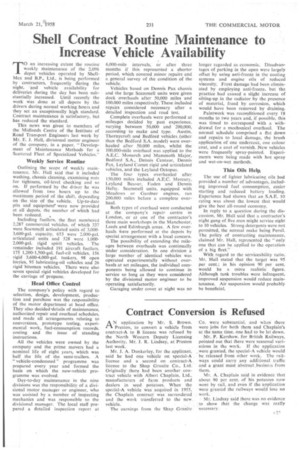Shell Contract Routine Maintenance to Increase Vehicle Availability
Page 59

If you've noticed an error in this article please click here to report it so we can fix it.
T0 an increasing extent the routine weekly maintenance of the 2,096 depot vehicles operated by ShellMcx and B.P., Ltd., is being performed by contractors, frequently during the night, and vehicle availability for deliveries during the day has been substantially increased. Until recently the work was done at all depots by the drivers during normal working hours and they set an exceptionally high standard. Contract maintenance is satisfactory, but
has reduced the standard. .
This news was given to members of the Midlands Centre of the InStitute of Road Transport Engineers last week by Mr. E. J. Hall, divisional motor engineer of the company, in a paper. "Development of Maintenance Methods for a Scattered Fleet of Specialized Vehicles,"
Weekly Service Routine
Outlining the scope of weekly maintenance, Mr. Hall said that it included washing, chassis cleaning, examining nuts for tightness, oil-level checking and so on. If performed by the driver he was allowed from two hours up to the maximum period of the shift, depending on the size of the vehicle. Up-to-date pits and equipment' were now provided at all depots. the number of which had been reduced. ...
Including fuellers, the fleet numbered 2,287 commercial vehicles, of which 337 were Scammell articulated units of 3,0003.600-gal. capacity, 653 were 2,000-gal. articulated units and 528 were 1.0002.000-gal. rigid spirit vehicles. The remainder included 191 aircraft fuellers, 175 1,200-1,500-gal. fuel-oil vehicles, 156 rigid 3,600-4,000-gal. tankers, 98 open lorries, 95 lubricating-oil vehicles and 26 rigid -bitumen vehicles. There were also seven special rigid vehicles developed for the carriage of propane.
Head Office Control
The company's policy with regard to selection, design, development, production and purchase was the responsibility of the motor department at head office. They also decided-details of maintenance, authorized repair and overhaul schedules, and made all arrangements relating to conversions, prototype testing, experimental work, fuel-consumption records. costing and the issue of standing instructions.
All the vehicles were owned by the company and the prime movers had a nominal life of eight years, which was half the life of the semi-trailers. A " vehicle-condemned" programme was prepared every year and formed the basis on which the new-vehicle programme was evolved.
Day-to-day maintenance in the nine divisions was the responsibility of a divisional motor manager or engineer, who was assisted by a number of inspecting mechanics and was responsible to the divisional manager. The local staff prepared a detailed inspection report at 6,000-mile intervals, or after three months if this represented a shorter period, which covered minor repairs and a general survey of the condition of the vehicle.
Vehicles based on Dennis Pax chassis and the large Scammell units were given dock overhauls after 50,000 miles and 100,000 miles respectively. These included repairs considered necessary after a detailed inspection and road test.
Complete overhauls were performed at mileages decided by past experience, varying between 50,000 and 200,000, according to make and type. Austin, Thornycroft and Bedford vehicles (other than the Bedford S.A. model) were overhauled after 50,000 miles-, whilst the 100,000-mile overhaul was applied to the A.E,C. Monarch and Mammoth Major, Bedford S.A., Dennis Centaur, Dennis Pax, Leyland Comet rigid and articulated vehicles, and the Leyland Octopus.
The four types overhauled after 150,000 miles included A.E.C. Mercury, Leyland Beaver, Foden and Dennis Hefty. Scammell units, equipped with Meadows or Gardner engines, ran 200,000 miles before a complete overhaul.
Both types of overhaul were conducted at the company's repair centre in London, or at one of the contractor's three main workshops in the Manchester. Leeds and Edinburgh areas. A few overhauls Were performed at the depots by special arrangement with a local concern.
The possibility of extending the mileages between overhauls was continually under consideration. In one division a large number of identical vehicles was operated experimentally without overhauls at set mileages, the individual components being allowed to continue in service so long as they were considered by the divisional motor engineer to be operating satisfactorily.
Garaging under cover at night was no longer regarded as economic. Disadvantages of parking in the open were largely offset by using anti-freeze in the cooling systems and engine oils of reduced viscosity. Frost damage had been eliminated by employing anti-freeze, but the practice had caused a slight increase of silting-pp in the radiator by the presence of material, freed by corrosion, which would have been removed by draining.
Paintwork was reconditioned every 18 months to two years and, if possible, this was timed to correspond with a withdrawal for a mechanical overhaul. The normal schedule comprised a flat down and repairs to local damage, the brush application of one undercoat, one colour coat, and a coat of varnish. New vehicles were frequently spray-painted. Experiments were being made with hot spray and wet-on-wet methods.
Thin Oils HeIR
The use of lighter lubricating oils had provided a number of advantages, including improved fuel consumption, easier starting and reduced battery loading. Experience had shown that an S.A.E. 10 rating was about the lowest that would give the best all-round economy.
In reply to a question during the discussion, Mr. Hall said that a contractor's night gang of five men might service eight to 10 vehicles. Strong detergents were not permitted, the normal make being Persil. The policy of contracting maintenance, claimed Mr. Hall, represented the "only one that can be applied to the operation of a big fleet.
With regard to the serviceability ratio, Mr. Hall stated that the target was 95 per cent.; in his opinion 90 per cent. would be a More realistic figure. Although tank troubles were infrequent, improved suspension would reduce maintenance. Air suspension would probably be beneficial,








































































































